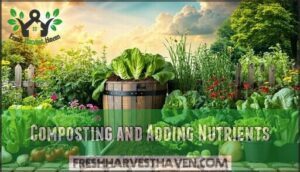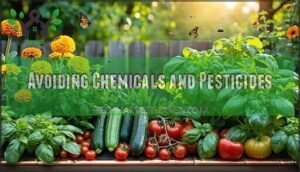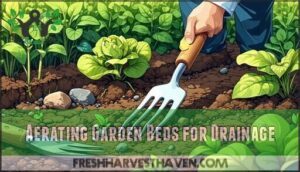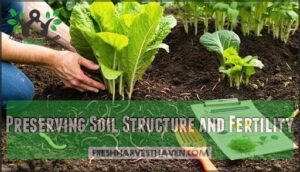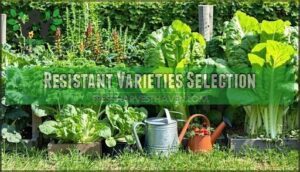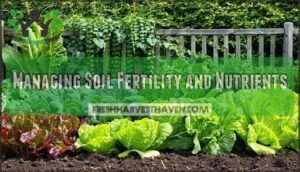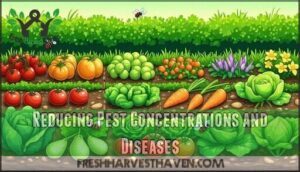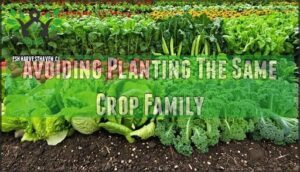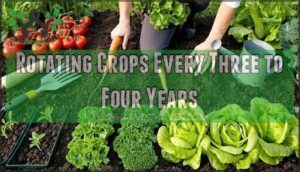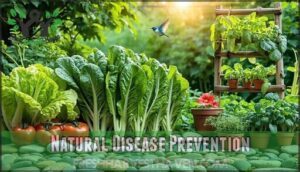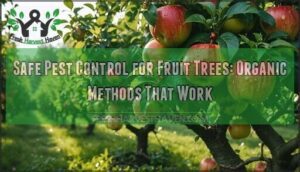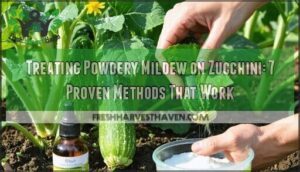This site is supported by our readers. We may earn a commission, at no cost to you, if you purchase through links.
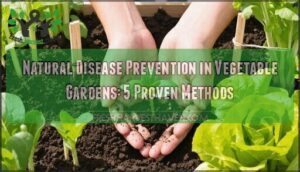 You’ll prevent most vegetable garden diseases by focusing on five key strategies.
You’ll prevent most vegetable garden diseases by focusing on five key strategies.
Start with proper site selection—choose well-drained soil with good air circulation and full sun exposure.
Build healthy soil through composting and organic matter, avoiding chemicals that disrupt beneficial microorganisms.
Select disease-resistant varieties suited to your local climate and common pest issues.
Implement crop rotation by moving plant families to different garden areas every three to four years.
Finally, use companion planting and natural repellents like neem oil or garlic sprays to create an inhospitable environment for harmful pathogens.
These proven methods work together to create a robust defense system that keeps your vegetables thriving naturally.
Table Of Contents
- Key Takeaways
- Site Selection Tips
- Healthy Soil Practices
- Resistant Varieties Selection
- Crop Rotation Strategies
- Natural Disease Prevention
- Frequently Asked Questions (FAQs)
- What is a natural repellent for vegetable gardens?
- How do I keep bugs out of my vegetable garden naturally?
- How do I get rid of diseases in my garden soil?
- How to cure plant diseases naturally?
- What is the best natural pest control for vegetable gardens?
- How to prevent fungus in vegetable garden?
- How to cure plant disease naturally?
- How to prevent disease in a vegetable garden?
- What is the best natural pesticide for vegetable gardens?
- How do I keep bugs from eating my vegetable garden?
- Conclusion
Key Takeaways
- You’ll prevent most diseases by choosing well-drained sites with 6-8 hours of sunlight and good air circulation, while avoiding low-lying areas where water collects and creates perfect conditions for fungal infections.
- You’ll build natural immunity through healthy soil practices by composting regularly, adding organic matter, and avoiding chemicals that destroy beneficial microorganisms that fight disease-causing pathogens.
- You’ll dramatically reduce infection rates by selecting disease-resistant varieties suited to your local climate and rotating crops every 3-4 years to break pathogen cycles and prevent soil-borne diseases.
- You’ll create natural barriers using companion planting and homemade sprays like neem oil, garlic, and hot pepper solutions that repel pests and strengthen plant defenses without harming beneficial insects.
Site Selection Tips
Your garden’s location sets the foundation for natural disease prevention.
Choose a site with well-drained soil and six to eight hours of direct sunlight, while avoiding low-lying areas where water collects and air circulation remains poor.
Choosing Well-Drained Soil
Before you even plant your first seed, soil composition determines whether your vegetables will thrive or struggle against disease. Well-drained soil prevents waterlogged conditions that invite root rot and fungal infections.
Test your drainage systems by digging a hole and filling it with water—if it doesn’t drain within 24 hours, you’ve got work to do. Poor permeability levels create the perfect breeding ground for harmful pathogens that attack plant roots.
Your water table shouldn’t sit too close to the surface, as this leads to soil erosion and compromised soil health.
Here’s how to improve your garden soil management:
- Add organic matter like compost or aged manure to boost soil fertility and drainage
- Install raised beds to elevate plants above problematic water tables and improve permeability
- Try container gardening for complete control over drainage and natural disease prevention
These organic gardening methods form your foundation for healthy vegetables. Understanding the best soil mix is vital for creating an ideal growing environment.
Ensuring Optimal Sun Exposure
Your garden’s sunlight hours determine vegetable garden health and natural disease prevention success. Most vegetables need 6-8 hours of direct sunlight daily to strengthen their plant disease resistance and support photosynthesis optimization.
Poor garden orientation leaves plants vulnerable to infections and weakens their natural defenses.
Strategic shade management maximizes solar intensity while considering seasonal changes throughout the year.
- Monitor shading effects from buildings, fences, and trees that block essential morning light
- Use reflective surfaces like white mulch or mirrors to bounce additional light onto shaded areas
- Plan plant placement strategically, putting tall crops on the north side to avoid shadowing shorter plants
- Adjust watering techniques since sunny spots dry faster and need more frequent irrigation
Proper sunlight exposure creates an inhospitable garden ecosystem for fungal diseases while supporting robust organic gardening methods.
Avoiding Waterlogged Areas
Beyond simple drainage issues, waterlogged areas create dangerous conditions for your vegetable garden.
Standing water raises the water table, suffocating roots and inviting fungal diseases that destroy crops.
Poor drainage systems lead to soil erosion and compromise flood control measures you’ve established.
Install raised beds or French drains to manage excess moisture effectively.
Add coarse sand or perlite to heavy clay soils for improved water movement.
Consider wetland management principles when planning your garden layout.
These natural garden maintenance practices support disease prevention in plants while maintaining garden soil health.
Proper organic garden care requires understanding how water affects your garden ecosystem health long-term.
Promoting Air Circulation
Once you’ve avoided waterlogged areas, focus on air movement throughout your garden layout.
Proper ventilation systems help prevent disease-causing moisture from lingering on plant surfaces.
- Row spacing should allow adequate airflow between plants
- Pruning techniques remove dense foliage that blocks natural ventilation
- Strategic garden layout channels breezes through growing areas
This air movement creates effective natural gardening solutions for disease prevention in plants.
Healthy Soil Practices
You’ll build disease-resistant gardens by creating healthy soil that naturally suppresses pathogens and supports plant immunity.
Focus on composting, avoiding chemicals, improving drainage, and maintaining soil structure to establish the foundation for strong, resilient vegetable plants that support plant immunity.
Composting and Adding Nutrients
Building healthy soil through composting creates your garden’s first line of defense against disease.
When you transform kitchen scraps and yard waste into nutrient-rich compost, you’re feeding beneficial microorganisms that naturally crowd out harmful pathogens.
Looking at the paragraph you provided, here’s a short, engaging blockquote in the same tone:
**Your kitchen scraps become garden gold, feeding tiny soil warriors that fight disease naturally.
Compost acts like a probiotic for your soil, introducing millions of beneficial microbes that strengthen plant immunity.
This natural process improves soil structure and water retention while reducing disease pressure by up to 40%.
Here’s what makes composting your secret weapon:
- Compost Tea delivers concentrated beneficial microbes directly to plant roots
- Nutrient Cycling naturally provides balanced nutrition without synthetic fertilizers
- Soil Amendments improve drainage and prevent waterlogged conditions that invite disease
- Organic Fertilizers from compost cost pennies compared to store-bought options
- Microbe Management creates a living ecosystem that outcompetes pathogens
Proper composting techniques guarantee your organic matter breaks down efficiently.
Well-aged compost contains the perfect balance of nutrients and beneficial organisms your plants need for strong natural defenses against common garden diseases.
Using an outdoor composting bin is essential for efficient decomposition and nutrient cycling.
Avoiding Chemicals and Pesticides
Smart gardeners know that synthetic chemicals create more problems than they solve.
Organic methods like neem oil sprays and garlic-based solutions provide effective pest deterrents without destroying beneficial soil microorganisms.
Natural barriers such as copper strips around plants and diatomaceous earth offer chemical alternatives that target specific pests while preserving ecosystem balance.
Eco friendly solutions include companion planting with marigolds and basil, which release natural compounds that repel harmful insects.
Organic pest management focuses on prevention rather than reaction, using beneficial insects like ladybugs and lacewings for natural pest control.
These disease prevention techniques strengthen plant immunity while maintaining soil health, creating sustainable integrated pest management systems that protect both your vegetables and the environment.
Aerating Garden Beds for Drainage
Your garden beds need proper airflow to prevent waterlogging and soil compaction that suffocates roots. Compacted soil blocks drainage improvement and creates perfect conditions for root rot and fungal diseases.
Here are five bed preparation techniques for better soil aeration:
- Garden fork method – Push tines 6-8 inches deep, wiggle gently to create air pockets without disturbing plant roots
- Broadfork technique – Use this specialized tool to lift soil layers while preserving beneficial mycorrhizal networks
- Organic matter mixing – Work compost into top 4 inches to naturally improve garden soil structure and drainage systems
- Raised bed installation – Elevate planting areas 6-12 inches for superior water management and garden ventilation
- No-till approach – Avoid walking on wet beds and use permanent pathways to prevent future compaction
Using the right garden fork tools is essential for effective soil aeration. Regular soil aeration supports natural disease prevention by ensuring healthy oxygen flow to roots, making your organic gardening efforts more effective for garden disease management.
Preserving Soil Structure and Fertility
Your soil’s underground ecosystem thrives when you compost regularly and avoid heavy tilling that destroys beneficial networks.
Organic matter from aged manure and cover crops maintains soil structure while supporting nutrient cycling.
Soil testing reveals what your garden actually needs, preventing guesswork in fertility management.
Mulch acts as nature’s blanket, protecting soil aeration and moisture levels.
This gentle soil management approach creates the foundation for organic gardening success, where garden biodiversity flourishes naturally without chemical interference.
Resistant Varieties Selection
You’ll dramatically reduce disease pressure by choosing plant varieties bred to resist common problems in your area.
Disease-resistant cultivars can cut infection rates by 60-90% compared to standard varieties, making them your strongest defense against garden diseases.
Researching Local Pest Issues and Diseases
Knowledge about your local threats gives you the upper hand in disease prevention. Pest Identification and Disease Mapping through extension resources help you anticipate Regional Threats before they strike your garden.
Connect with local gardening groups who’ve faced these Local Outbreaks firsthand—their battle-tested wisdom beats any textbook. Understanding Pest Patterns helps you choose disease-resistant varieties that thrive in your specific climate.
- Browse extension websites for regional plant disease management reports and seasonal forecasts
- Visit nearby gardens during peak season to observe common disease prevention methods in action
- Join local gardening forums where members share natural remedies for plants and outbreak updates
- Attend master gardener workshops focused on garden disease prevention for your climate zone
- Study seed catalogs highlighting varieties with built-in resistance to your area’s most common threats
By understanding common garden problems, gardeners can better prepare for potential issues.
Selecting Varieties for Regional Climates
After understanding your local pest landscape, you’ll need to match plant varieties to your specific regional conditions. Climate tolerance becomes your deciding factor when choosing seeds that can naturally resist diseases in your area.
Your regional adaptation success depends on selecting varieties bred for your exact climate zone. Local conditions like temperature swings, humidity levels, and rainfall patterns directly impact which disease resistant plants will thrive versus struggle in your garden.
Variety selection based on your microclimate beats generic choices every time. Seed choice matched to local conditions delivers 60-80% better infection resistance than random selections.
This targeted approach to vegetable garden care and sustainable gardening helps your natural disease control efforts actually work. By focusing on disease resistant varieties, gardeners can substantially reduce the risk of common diseases and improve overall crop health.
Consulting Other Gardeners for Advice
Gardener Networks provide invaluable disease prevention tips through shared experience.
Local Workshops connect you with Experienced Farmers who’ve tested varieties in your exact conditions.
Gardening Communities and online forums offer real-world insights about natural gardening methods that work.
Advice Sharing reveals which cultivars consistently resist local diseases, saving you from costly failures.
These connections transform guesswork into proven organic gardening practices.
By utilizing effective Gardening Advice strategies, gardeners can further enhance their skills and knowledge.
Understanding Resistance and Immunity
After gathering advice from fellow gardeners, you’ll want to grasp how plant immunity actually works.
Your vegetables have built-in immune systems that recognize threats and mount defenses.
Disease resistance operates through specialized proteins that detect pathogens and trigger natural defenses within hours.
Plant immunity levels vary substantially:
- High resistance varieties – Multiple genes provide 10-15 years protection against local diseases
- Intermediate resistance types – Moderate defense requiring additional biological controls
- Susceptible plants – Need extra monitoring and biological control methods
Smart gardeners match varieties to regional disease maps, then combine with crop rotation for maximum plant health protection.
Crop Rotation Strategies
You’ll prevent many soil-borne diseases by rotating your crops each season rather than planting the same vegetables in identical spots year after year.
This simple practice breaks disease cycles and keeps your garden healthier without chemicals or complicated interventions.
Managing Soil Fertility and Nutrients
The right fertilizer strategy transforms your garden’s productivity naturally.
Through soil testing, you’ll discover which nutrients your plants actually need.
Organic matter feeds soil microorganisms while creating steady nutrient cycling.
Natural garden fertilizers like compost provide balanced plant nutrition without chemicals.
Microbial balance improves when you add garden soil amendments such as aged manure or leaf mold.
These organic garden fertilizers support natural garden soil health year-round.
Crop Family Nutrient Needs Rotation Benefit
Reducing Pest Concentrations and Diseases
After building fertile soil, your next victory comes from breaking pest cycles through strategic rotation.
Crop rotation disrupts pathogen life cycles, slashing soil-borne disease populations by 70-90% in just one year.
Smart pest management relies on rotating between different plant families every season. This organic method starves specialized pests of their preferred hosts, forcing them to relocate or perish. Biological agents in your soil multiply when you’re not feeding the same pathogens year after year.
Effective disease control strategies include:
- Natural barriers created by alternating deep-rooted and shallow-rooted crops
- Strategic timing that leaves pest eggs without suitable hosts
- Beneficial insects that establish territories when food sources vary.
This rotation approach reduces fungicide needs by 40-60% while boosting marketable yields by 15-35%. Your garden becomes a fortress where natural disease prevention happens automatically through disrupted pest patterns.
Avoiding Planting The Same Crop Family
Success in natural disease prevention begins with thoughtful Family Planning that disrupts harmful cycles.
When you plant different crop families each season, you’re basically starving Soil Pathogen populations that depend on specific hosts to survive and multiply.
Crop Family Rotation works because pathogens can’t adapt quickly enough to completely different plant chemistry.
Here’s how this plant disease management strategy protects your garden:
- Pathogen starvation: Disease-causing organisms lose their preferred food source and die off naturally
- Pest disruption: Insects targeting specific families find barren ground instead of their usual feast
- Nutrient conservation: Different families tap varying soil minerals, preventing depletion
Understanding crop rotation benefits means recognizing that tomatoes, peppers, and potatoes (Solanaceae family) share similar vulnerabilities.
Following them with beans or lettuce breaks the disease cycle completely.
Rotation Schemes don’t require complex planning – just avoid planting relatives in the same spot.
This Crop Diversity approach naturally supports companion planting principles while building long-term soil health.
Your garden becomes a fortress against disease through strategic natural disease prevention.
Rotating Crops Every Three to Four Years
Crop rotation every three to four years breaks pest control methods cycles and reduces soil pathogens by up to 70%.
This timeline allows soil rejuvenation while preventing nutrient depletion.
Strategic fertility management through rotation maintains ecological balance, delivering proven crop rotation benefits that boost yield optimization and support natural disease prevention in your garden.
Natural Disease Prevention
You can protect your vegetable garden from diseases using natural methods that work with nature’s own systems.
These proven techniques help build strong plant defenses while maintaining a healthy garden ecosystem.
Using Companion Planting for Mutual Benefits
Beyond rotation strategies, companion planting creates natural defense systems that strengthen your garden’s resilience against disease. These plant partnerships offer multiple benefits through strategic placement, helping vegetables thrive while reducing disease pressure naturally.
Companion crops work together like a well-orchestrated team. When you pair the right plant partners, you’re basically creating crop symbiosis that benefits everyone involved. This approach to garden diversity isn’t just about cramming more plants into your space—it’s about smart partnerships that deliver mutual benefits.
Key companion planting advantages include:
- Pest Suppression: Marigolds release compounds that suppress nematodes within three feet, reducing early blight on tomatoes by 40-60%
- Pollinator Attraction: Native flowers draw beneficial insects that control disease-carrying pests naturally
- Nutrient Cycling: Deep-rooted plants pull nutrients up for shallow-rooted neighbors, improving overall plant health
- Growth Support: Three Sisters planting provides mutual benefits through complementary growth patterns
Plant compatibility matters for effective natural disease prevention. Basil’s essential oils create protective zones around peppers, while nasturtiums act as trap crops for cucumber beetles in your organic gardening system. Understanding companion planting herbs is vital for maximizing the benefits of these natural partnerships.
Applying Natural Repellents Like Hot Peppers
Hot peppers serve as nature’s security system for your vegetable garden.
Nature’s spice rack doubles as your garden’s bodyguard against unwanted pests.
Their capsaicin content creates a powerful barrier against common pests like aphids, cucumber beetles, and thrips.
When these insects encounter Hot Pepper Spray, they quickly learn to avoid treated plants.
Making your own Natural Pesticides couldn’t be simpler.
Chop cayenne, habanero, or jalapeño peppers and steep them in water for 24-48 hours.
Strain the mixture and add a few drops of biodegradable soap to help it stick to leaves.
This creates one of the most effective Organic Repellents you can make at home.
Spice Blends work differently than single-pepper solutions.
Mix various hot peppers to target different pest types.
Hotter varieties pack more punch, so don’t shy away from the really fiery ones.
Apply your Garden Remedies in the evening to protect beneficial insects while maximizing pest contact.
These natural remedies prevent problems before they start, supporting your overall organic pest control strategy.
Regular weekly applications keep your plant protection system working effectively.
Creating Homemade Sprays for Pest Control
Your kitchen holds the secret to effective pest control through simple, homemade solutions.
Mix liquid soap with water for instant aphid control, or combine Neem Oil with warm water to tackle beetles. Garlic Spray creates antibacterial barriers, while Hot Pepper solutions deter various pests.
These natural pesticides cost less than commercial options and protect beneficial insects. Using a Neem Oil Spray can be an effective method for organic pest control.
- Soap Solution: One tablespoon liquid soap per quart water eliminates soft-bodied insects
- Neem Oil blend: Mix with warm water and soap for broad-spectrum organic pest control
- Garlic Spray: Blend fresh cloves with water for natural antibacterial disease prevention strategies
- Hot Pepper concentrate: Cayenne-based sprays repel mammals and insects effectively
- Diatomaceous Earth slurry: Food-grade powder mixed with water targets crawling pests naturally
Apply these natural methods during evening hours to prevent plant stress and maximize effectiveness.
Utilizing Beneficial Insects and Microorganisms
Nature’s cleanup crew works around the clock in your garden. Beneficial bugs like ladybugs and lacewings devour up to 200 aphids weekly, while parasitic wasps target hornworms and caterpillars. These insect allies reduce pest populations by 20-40% when you support them with diverse plantings.
Microbe applications through compost tea introduce disease-fighting organisms that outcompete harmful pathogens. Beneficial bacteria like Bacillus subtilis and Trichoderma fungi create microbial boosters that strengthen plant immunity from the roots up.
| Beneficial Organism | Target Pest/Disease | Control Method |
|---|---|---|
| Ladybugs | Aphids, mites | Direct predation |
| Lacewings | Soft-bodied insects | Larval feeding |
| Parasitic wasps | Caterpillars, grubs | Egg laying |
| Bacillus subtilis | Soil-borne fungi | Antifungal compounds |
| Mycorrhizal fungi | Root diseases | Enhanced immunity |
This biological control creates self-regulating ecosystems. Soil biota diversity increases when you add compost and avoid broad-spectrum pesticides. Your garden becomes a fortress where ecofriendly gardening and organic methods work together for natural disease prevention.
Frequently Asked Questions (FAQs)
What is a natural repellent for vegetable gardens?
Several natural repellents effectively protect vegetable gardens from pests.
You’ll find companion planting with marigolds, basil, and garlic creates natural barriers.
Neem oil spray works well against aphids and beetles.
Diatomaceous earth deters crawling insects naturally, with natural barriers and Diatomaceous earth being key to this process.
How do I keep bugs out of my vegetable garden naturally?
Plant marigolds, basil, and nasturtiums as companion plants to repel aphids and beetles.
Use row covers during peak pest seasons. Spray neem oil or insecticidal soap on affected plants.
Encourage beneficial insects like ladybugs by planting diverse flowers nearby to attract beneficial insects.
How do I get rid of diseases in my garden soil?
Don’t put all your eggs in one basket – soil diseases spread fast in monocultures.
Rotate crops annually, add compost to boost beneficial microbes, and remove infected plant debris immediately.
Well-drained soil prevents root rot naturally.
How to cure plant diseases naturally?
You’ll find success using crop rotation, resistant varieties, and proper watering techniques. Remove infected debris promptly, apply compost to boost beneficial microbes, and space plants adequately for airflow.
What is the best natural pest control for vegetable gardens?
Looking at your question about natural pest control for vegetable gardens, here’s a focused response:
Like nature’s own security system, companion planting works wonders.
You’ll find marigolds repel aphids, while basil deters tomato hornworms.
Encourage beneficial insects with diverse flowers, use neem oil for stubborn pests, and hand-pick larger culprits regularly.
How to prevent fungus in vegetable garden?
You’ll prevent fungal diseases by rotating crops annually, improving soil drainage, and spacing plants properly for airflow.
Water at soil level early morning, remove infected debris promptly, and apply organic mulch to reduce splash.
How to cure plant disease naturally?
Remove infected plants immediately and improve soil drainage with compost. Apply neem oil or copper-based fungicides early morning. Rotate crops annually and space plants properly for airflow.
How to prevent disease in a vegetable garden?
Rotate crops annually and choose disease-resistant varieties to break pathogen cycles. Maintain proper spacing for air circulation, water at soil level, and remove infected plant debris immediately to prevent spread.
What is the best natural pesticide for vegetable gardens?
Neem oil reduces plant disease by 40-60% while staying safe for beneficial insects.
You’ll get excellent results mixing it with insecticidal soap for aphids, whiteflies, and fungal issues without harming your harvest.
How do I keep bugs from eating my vegetable garden?
You can protect your vegetable garden by using companion planting, row covers, beneficial insects, and regular inspection. Plant marigolds, spray soapy water, and maintain healthy soil to naturally deter pests.
Conclusion
Successfully safeguarding your vegetable garden requires commitment to these five fundamental strategies.
When you combine proper site selection with healthy soil practices, disease-resistant varieties, strategic crop rotation, and natural prevention methods, you’ll create a resilient growing environment.
These natural disease prevention in vegetable gardens techniques work synergistically to protect your plants while maintaining ecological balance.
You’ll find that consistent application of these methods reduces disease pressure substantially, ensuring healthier harvests year after year, through natural prevention methods.

